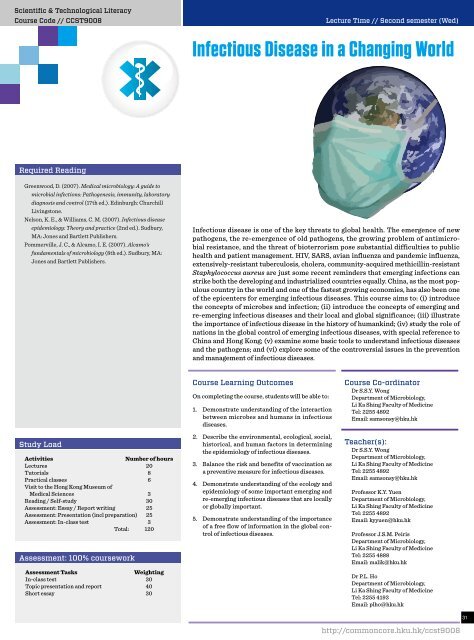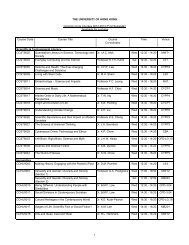handbook - HKU Common Core Curriculum - The University of Hong ...
handbook - HKU Common Core Curriculum - The University of Hong ...
handbook - HKU Common Core Curriculum - The University of Hong ...
You also want an ePaper? Increase the reach of your titles
YUMPU automatically turns print PDFs into web optimized ePapers that Google loves.
Scientific & Technological Literacy<br />
Course Code // CCST9008<br />
Required Reading<br />
Greenwood, D. (2007). Medical microbiology: A guide to<br />
microbial infections: Pathogenesis, immunity, laboratory<br />
diagnosis and control (17th ed.). Edinburgh: Churchill<br />
Livingstone.<br />
Nelson, K. E., & Williams, C. M. (2007). Infectious disease<br />
epidemiology: <strong>The</strong>ory and practice (2nd ed.). Sudbury,<br />
MA: Jones and Bartlett Publishers.<br />
Pommerville, J. C., & Alcamo, I. E. (2007). Alcamo’s<br />
fundamentals <strong>of</strong> microbiology (8th ed.). Sudbury, MA:<br />
Jones and Bartlett Publishers.<br />
Study Load<br />
Activities Number <strong>of</strong> hours<br />
Lectures 20<br />
Tutorials 8<br />
Practical classes 6<br />
Visit to the <strong>Hong</strong> Kong Museum <strong>of</strong><br />
Medical Sciences 3<br />
Reading / Self-study 30<br />
Assessment: Essay / Report writing 25<br />
Assessment: Presentation (incl preparation) 25<br />
Assessment: In-class test 3<br />
Total: 120<br />
Assessment: 100% coursework<br />
Assessment Tasks Weighting<br />
In-class test 30<br />
Topic presentation and report 40<br />
Short essay 30<br />
Lecture Time // Second semester (Wed)<br />
Infectious Disease in a Changing World<br />
Infectious disease is one <strong>of</strong> the key threats to global health. <strong>The</strong> emergence <strong>of</strong> new<br />
pathogens, the re-emergence <strong>of</strong> old pathogens, the growing problem <strong>of</strong> antimicrobial<br />
resistance, and the threat <strong>of</strong> bioterrorism pose substantial difficulties to public<br />
health and patient management. HIV, SARS, avian influenza and pandemic influenza,<br />
extensively-resistant tuberculosis, cholera, community-acquired methicillin-resistant<br />
Staphylococcus aureus are just some recent reminders that emerging infections can<br />
strike both the developing and industrialized countries equally. China, as the most populous<br />
country in the world and one <strong>of</strong> the fastest growing economies, has also been one<br />
<strong>of</strong> the epicenters for emerging infectious diseases. This course aims to: (i) introduce<br />
the concepts <strong>of</strong> microbes and infection; (ii) introduce the concepts <strong>of</strong> emerging and<br />
re-emerging infectious diseases and their local and global significance; (iii) illustrate<br />
the importance <strong>of</strong> infectious disease in the history <strong>of</strong> humankind; (iv) study the role <strong>of</strong><br />
nations in the global control <strong>of</strong> emerging infectious diseases, with special reference to<br />
China and <strong>Hong</strong> Kong; (v) examine some basic tools to understand infectious diseases<br />
and the pathogens; and (vi) explore some <strong>of</strong> the controversial issues in the prevention<br />
and management <strong>of</strong> infectious diseases.<br />
Course Learning Outcomes<br />
On completing the course, students will be able to:<br />
1. Demonstrate understanding <strong>of</strong> the interaction<br />
between microbes and humans in infectious<br />
diseases.<br />
2. Describe the environmental, ecological, social,<br />
historical, and human factors in determining<br />
the epidemiology <strong>of</strong> infectious diseases.<br />
3. Balance the risk and benefits <strong>of</strong> vaccination as<br />
a preventive measure for infectious diseases.<br />
4. Demonstrate understanding <strong>of</strong> the ecology and<br />
epidemiology <strong>of</strong> some important emerging and<br />
re-emerging infectious diseases that are locally<br />
or globally important.<br />
5. Demonstrate understanding <strong>of</strong> the importance<br />
<strong>of</strong> a free flow <strong>of</strong> information in the global control<br />
<strong>of</strong> infectious diseases.<br />
Course Co-ordinator<br />
Dr S.S.Y. Wong<br />
Department <strong>of</strong> Microbiology,<br />
Li Ka Shing Faculty <strong>of</strong> Medicine<br />
Tel: 2255 4892<br />
Email: samsonsy@hku.hk<br />
Teacher(s):<br />
Dr S.S.Y. Wong<br />
Department <strong>of</strong> Microbiology,<br />
Li Ka Shing Faculty <strong>of</strong> Medicine<br />
Tel: 2255 4892<br />
Email: samsonsy@hku.hk<br />
Pr<strong>of</strong>essor K.Y. Yuen<br />
Department <strong>of</strong> Microbiology,<br />
Li Ka Shing Faculty <strong>of</strong> Medicine<br />
Tel: 2255 4892<br />
Email: kyyuen@hku.hk<br />
Pr<strong>of</strong>essor J.S.M. Peiris<br />
Department <strong>of</strong> Microbiology,<br />
Li Ka Shing Faculty <strong>of</strong> Medicine<br />
Tel: 2255 4888<br />
Email: malik@hku.hk<br />
Dr P.L. Ho<br />
Department <strong>of</strong> Microbiology,<br />
Li Ka Shing Faculty <strong>of</strong> Medicine<br />
Tel: 2255 4193<br />
Email: plho@hku.hk<br />
http://commoncore.hku.hk/ccst9008<br />
31



